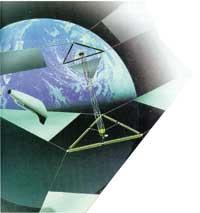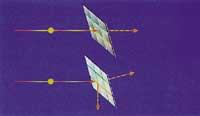Awnings in space
The awnings circulate in space in the sea as driven by the wind. In space, which is driven by the sun's winds, motorless probes will circulate pushed with inflated sun fabrics from next year.

The interstellar vacuum without a motor seems impossible, but it can circulate with the radiations emitted by the Sun (light and solar wind), which little push the bodies found on the road. The solar wind is formed by electrons, protons and heavy cores, but by exercising a pressure 100,000 times lower than photons, only photons are taken into account to navigate the fabric.
Kepler saw in 1616 that the solar wind pushed the comet tails in the opposite direction to the Sun. In fact, when photons are found with some surface, they leave part of their amount of movement. The bodies that suck or reflect the photons suffer a pressure force called radiation pressure. The pressure is double when the photon is reflected. The thrust of the reflected photon is perpendicular to the fabric, and its orientation allows to control the package path.
The thrust decreases depending on the square of the distance to the Sun and is really very small. It does not serve to move near the ground and on the surface that reflects it, the thrust is only of 9 micronewtons, that is, equal to the pressure of the water column of thousandth height. Of course, it is very small, but since there is no resistance that stops in space, it must be taken into account. In addition, the sailboat has a constant acceleration and can reach incredible speeds.
If light has the function of wind, the gravitational forces of the planets and the Sun have the role of marine currents. To escape the gravitation of the Earth, the sailboat must initially turn around the Earth, forming larger and larger ellipses.
The impulse of photons was used in 1970 to guide the Meriner 10 probe that was directed towards Mercury. On the other hand, the Russians experienced in February 1993 with the extension of a reflective membrane of a few micrometers thick. It was then that the Znamya project of engineer Vladimir Syromiatnikov was launched. The 20 metre diameter circular fabric was baptized as Znamya 2 and used as a solar reflector (not for locomotion). The objective was to send solar rays to the Earth and illuminate a circle of a few kilometers of diameter at the height of the Full Moon. The session was held again in February of this year with 2.5 fabrics (25 meters in diameter and 5 in full moon light) and have not been successful. The fabric is located in the Mir space station since October 27 last year.

Finally, the Syromiatnikov project aims to place a hundred reflectors at an altitude of between 1,500 and 5,500 kilometers. These will provide any clear point in the world, such as the pole with a six-month night. However, some astronomers already complain that this light pollution is going to hinder their nocturnal research. Ecologists also fear that this artificial light will not alter the ecosystem.
However, Znamya is only the first step for photon propulsion. They are not, on their own, space sailboats, but solar mirrors in orbit. In the next millennium there is the hope that the first candles will illuminate.
The first pilot container of solar fabric can be the Star of Tolerance. It will appear on January 1, 2001 at night and the XXI. At the beginning of the twentieth century as a symbol against violence. Nersi Razavi, UNESCO advisor, is responsible for this project, with the collaboration of the French Aero Club and the German space agency DLR. It needs about 45 million dollars (6,750 billion pesetas/270 million pounds) to run the project. If successful, your star will shine for two years before investigating the solar system.
Star Tolerance will be a square fabric of 40 meters of side. It will be a 5 micrometer thick plastic membrane, made with a material called capton. It will be reflective because a very thin layer of aluminum will be placed. When it expands in space it can be seen from the earth with the same luminosity as Venus.

Nersi Razavi wants to create tolerance squares in 2001 cities around the world to create a "chain of solidarity for peace". Every time the Star of Tolerance appears on one of these cities, the lights of the towers and great monuments will be turned off and the Plaza de la Tolerance will be illuminated. The signals issued by the satellite will issue messages against violence distributed by terrestrial communication networks. Then, the Star of Tolerance will fulfill its scientific objective: Measure the propulsion of photons in search of comets and asteroids of the solar system. The Toldo is specifically prepared for this, as it can reach very high speeds of up to 500,000 km/h and higher, along with comets and asteroids. You may also be able to collect samples and exploit asteroid materials.
Another problem to solve is the folded and extended fabric. When launched from the earth it is convenient to have as little volume as possible and expand without causing any damage when it is in space. Another option would be to manufacture the reflective membrane in the orbit itself. Some square kilometers of fabrics would reach Mars a few weeks and Jupiter a few months. However, all this can be carried out at the end of the following century.





